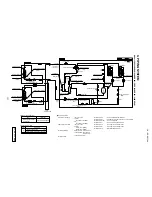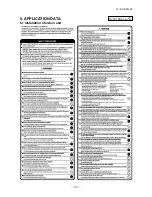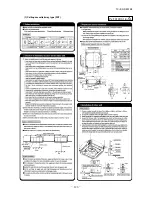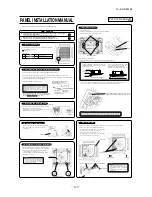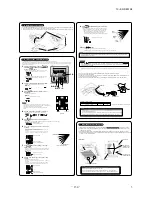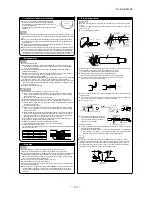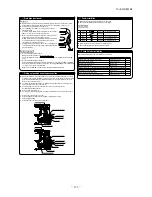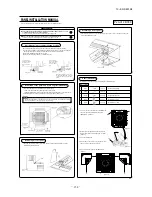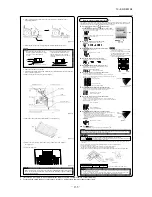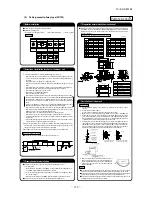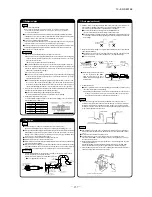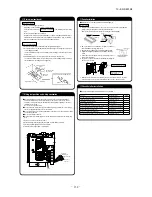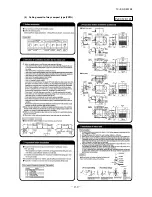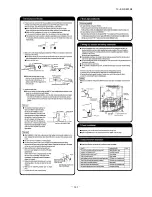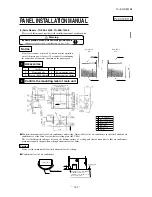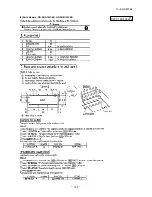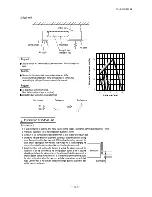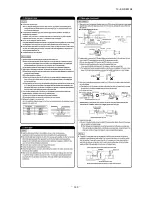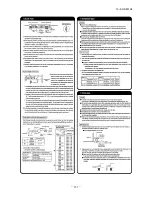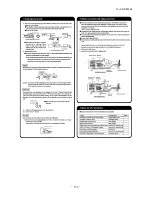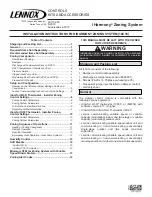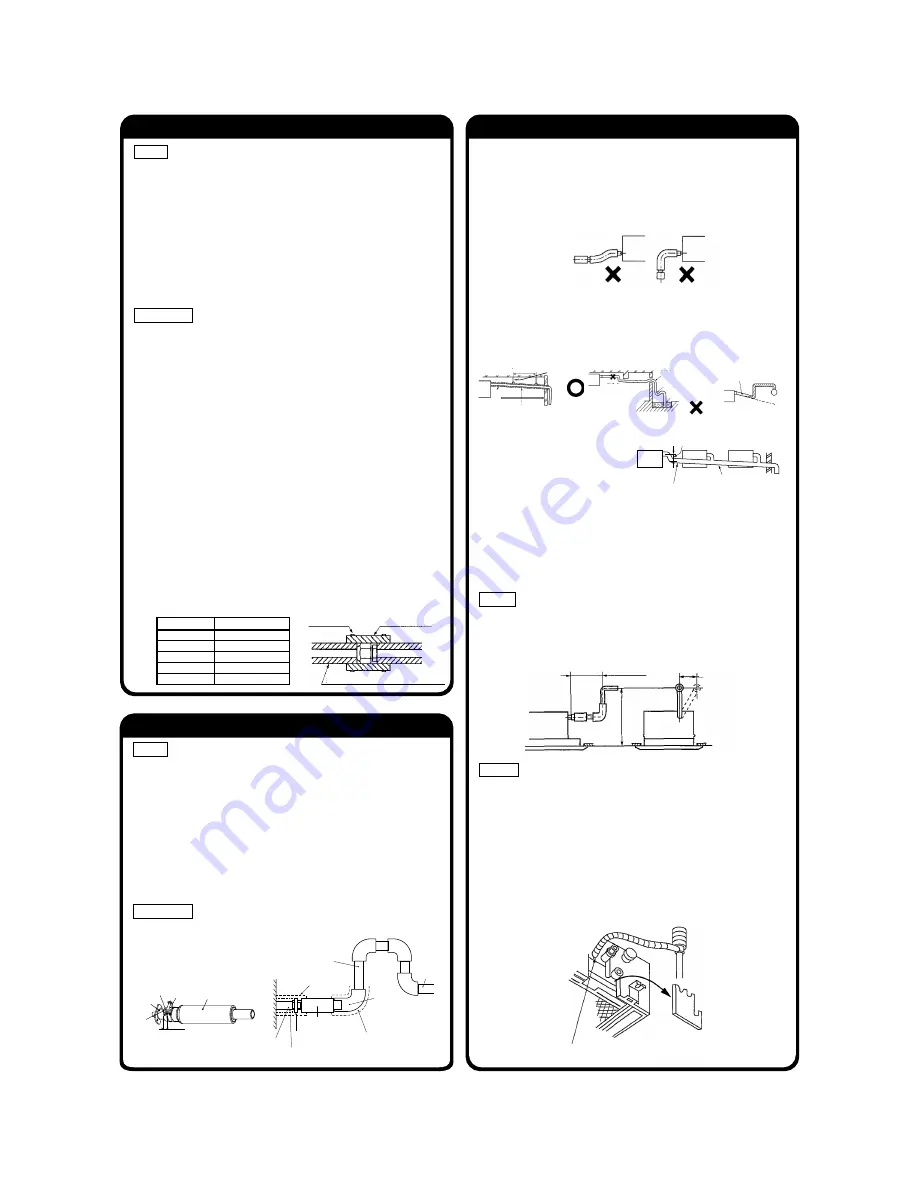
-
137
-
'10 • KX-SM-148
⑥
Drain pipe (continued)
⑤
Refrigerant pipe
⑥
Drain pipe (continued)
2. Prepare a joint for connecting VP-20 pipe, adhere and connect the joint to the drain hose
(the end made of rigid PVC), and adhere and connect VP-20 pipe (prepare on site).
※
As for drain pipe, apply VP-20 made of rigid PVC which is on the market.
●
Make sure that the adhesive will not get into the supplied drain hose.
It may cause the flexible part broken after the adhesive is dried up and gets rigid.
●
The flexible drain hose is intended to absorb a small difference at installation of the unit
or drain pipes. Intentional bending, expanding may cause the flexible hose broken and
water leakage.
3. Make sure to make descending slope of greater than 1/100 and do not make up-down bend
and/or trap in the midway.
●
Pay attention not to give stress on the pipe on the indoor unit side, and support and fix
the pipe as close place to the unit as possible when connecting the drain pipe.
●
Do not set up air vent.
●
When sharing a drain pipe for more than
one unit, lay the main pipe 100mm
below the drain outlet of the unit. In
addition, select VP-30 or bigger size for
main drain pipe.
⑧
Panel installation
Drain pump operation
○
In case electrical wiring work finished
Drain pump can be operated by remote controller (wired).
For the operation method, refer to Operation for drain pump in the installation manual for wiring
work.
○
In case electrical wiring work not finished
Drain pump will run continuously when the dip switch“SW7-1” on the indoor unit PCB is turned ON, the Connec-
tor CNB is disconnected, and then the power supply (230VAC on the terminal block
①
and
②
) is turned ON.
Make sure to turn OFF “SW7-1” and reconnect the Connector CNB after the test.
In case of gravity drainage
1. Remove the rubber plug and insulation from the gravity drainage port.
2. Connect the drain hose (VP-20) using the Gravity drainage connecting tube (option) and
secure firmly with a clamp.
(
﹡
If the drain tube is directly connected with the gravity drainage port, the drain pan could not
be removed.)
3. Find CNR drain motor connector (blue, 2P) in the control box, and remove it.
(
﹡
If the unit is used with this connector being connected, the drainage will go out through
the standard drain connecting port, causing leaks.)
⑦
Wiring-out position and wiring connection
●
Electrical installation work must be performed according to the installation manual by an
electrical installation service provider qualified by a power provider of the country, and be
executed according to the technical standards and other regulations applicable to electrical
installation in the country.
Be sure to use an exclusive circuit.
●
Use specified cord, fasten the wiring to the terminal securely, and hold the cord securely in
order not to apply unexpected stress on the terminal.
●
Do not put both power source line and signal line on the same route. It may cause miscommu-
nication and malfunction.
●
Be sure to do D type earth work.
●
For the details of electrical wiring work, see attached instruction manual for electrical wiring
work.
1. Remove a lid of the control box (2 screws).
2. Hold each wiring inside the unit and fasten them to a terminal block securely.
3. Fix the wiring with supplied screw, nut and washer.
4. Install the removed parts back to original place.
750mm or less
100mm or less
295
~
325mm
⑥
Drain pipe
Pipe cover (small)
(For insulation) (Accessory)
Pipe cover (For insulation)
(Prepare on site)
Unit
Pipe cover (big)
(For insulation) (Accessory)
VP-20
(Prepare on site)
Joint for VP-20
(Prepare on site)
VP-20
(Prepare on site)
Drain hose
(Accessory)
Drain socket
Clamp (Accessory)
(No adhesive allowed)
Gravity drainage port
Control box
Rubber plug
(Remove)
General hard type
PV pipe VP-20
Transparent soft tube
(option)
Connector for drain motor CNR (blue, 2P)
Remove
Insulation
●
Attach the panel on the indoor unit after electrical wiring work.
Work procedure
1. Using the paper pattern attached as an accessory, check to ensure the unit height and
ceiling opening are finished true to the specified dimensions.
Remove the suction panel from the panel assembly. (Ref. below diagram)
2. Among the bolts which are attached to the panel, 2 screw must
be inserted 5mm at the diagonal positions.
3. Hang the panel on the 2 bolts and temporarily tighten them.
4. Tighten the temporarily tightened 2 bolts and the remaining
2 bolts.
5. Tighten the 2 short bolts (15mm) at the louver supporting section of
blower outlet central part.
6. Connect the connecter of louver motor and limit switch through the
side cutout of control box.
7. When the louver motor does not operate by the remote controller operation, check the
connection of the connector, turn off the power for 10 seconds or longer, and reset.
Suction panel
Panel assembly
Remove
Short bolt
Louver support
(Sectional view of blower
outlet central part)
Pipe diameter
Tightening torque N·m
φ
6.35
φ
9.52
φ
12.7
φ
15.88
φ
19.05
14 to 18
34 to 42
49 to 61
68 to 82
100 to 120
Strap (Accessory)
Pipe cover (Accessory)
The thickness of insulation should be 20mm or more.
Earth
Indoor power
source line
Remote controller
line
Signal line
(Shielded cord)
CNR
CNJ2
CNM3
CNW1
2
1
X
Y
B
A
Power cable
Earth
Signal cable
for oller
Passing through this side cutout
Connect to relay connector
in the controll box.
X
Y
B
A
Signal cable
Signal cable for remote controller
Caution
●
Install the drain pipe according to the installation manual in order to drain properly.
Imperfection in draining may cause flood indoors and wetting the household goods
,
etc.
●
Do not put the drain pipe directly into the ditch where toxic gas such as sulfur, the other harmful and
inflammable gas is generated. Toxic gas would flow into the room and it would cause serious
damage to user’s health and safety (some poisoning or deficiency of oxygen). In addition, it may
cause corrosion of heat exchanger and bad smell.
●
Connect the pipe securely to avoid water leakage from the joint.
●
Insulate the pipe properly to avoid condensation drop.
●
Check if the water can flow out properly from both the drain outlet on the indoor unit and the end
of the drain pipe after installation.
●
Make sure to make descending slope of greater than 1/100 and do not make up-down bend and/or trap
in the midway. In addition, do not put air vent on the drain pipe. Check if water is drained out properly
from the pipe during commissioning. Also, keep sufficient space for inspection and maintenance.
Work procedure
1. Insert the supplied drain hose (the end made of soft PVC) to the step of the drain socket on
the indoor unit and fix it securely with the clamp.
Attach the hose clamp to the drain hose around 10mm from the end.
●
Do not apply adhesives on this end.
Descending slope greater than 1/100
As wide as possible
(about100mm)
Insulation material
Supporting metal
Descending slope greater than 1/100
Air vent
No bump
No trap
Not touching the water
Trapped air will
generate noises.
VP-30 or bigger
1.5m~2m
4. Insulate the drain pipe.
●
Be sure to insulate the drain socket and rigid PVC pipe installed indoors otherwise it may
cause dew condensation and water leakage.
※
After drainage test implementation, cover the drain socket part with pipe cover (small size), then
use the pipe cover (big size) to cover the pipe cover (small size), clamps and part of the drain
hose, and fix and wrap it with tapes to wrap and make joint part gapless.
Drain up
●
The position for drain pipe outlet can be raised up to 750mm above the ceiling. Use elbows for
installation to avoid obstacles inside ceiling. If the horizontal drain pipe is too long before vertical pipe,
the backflow of water will increase when the unit is stopped, and it may cause overflow of water from
the drain pan on the indoor unit. In order to avoid overflow, keep the horizontal pipe length and offset of
the pipe within the limit shown in the figure below.
Pipe cover
Pull in the hose pump about 50mm.
Drain test
●
After installation of drain pipe, make sure that drain system work in good condition and no
water leakage from joint and drain pan. Check if the motor sound of drain pump is normal
or not.
●
Do drain test even if installation of heating season.
●
For new building cases, make sure to complete the test before hanging the ceiling.
1. Pour water of about 1000cc into the drain pan in the indoor unit by pump so as not to get
the electrical component wet.
2. Make sure that water is drained out properly and there is no water leakage from any joints
of the drain pipe at the test.
Confirm that the water is properly drained out while the drain motor is operating. At the
drain socket (transparent), it is possible to check if the water is drained out properly.
3. Unplug the drain plug on the indoor unit to remove remaining water on the drain pan after the test,
and re-plug it. And insulate the drain pipe properly finally.
Pin(B)
Pin(A)
Panel outer
frame
Panel inside
parts
PJB012D227
A
Caution
●
Use the new refrigerant pipe.
When re-using the existing pipe system for R22 or R407C, pay attention to the following items.
・
Change the flare nuts with the attached ones (JIS category 2), and reprocess the flare parts.
・
Do not use thin-walled pipes.
●
Use phosphorus deoxidized copper alloy seamless pipe (C1220T specified in JIS H3300) for refrigeration pipe installation.
In addition, make sure there is no damage both inside and outside of the pipe, and no harmful
substances such as sulfur, oxide, dust or a contaminant stuck on the pipes.
●
Do not use any refrigerant other than R410A.
Using other refrigerant except R410A (R22 etc.) may degrade inside refrigeration oil. And air getting into
refrigeration circuit may cause over-pressure and resultant it may result in bursting, etc.
●
Store the copper pipes indoors and seal the both end of them until they are brazed in order to avoid any dust, dirt or
water getting into pipe. Otherwise it will cause degradation of refrigeration oil and compressor breakdown, etc.
●
Use special tools for R410 refrigerant.
Work procedure
1. Remove the flare nut and blind flanges on the pipe of the indoor unit.
※
Make sure to loosen the flare nut with holding the nut on pipe side with a spanner and giving
torque to the nut with another spanner in order to avoid unexpected stress to the copper
pipe, and then remove them.
(Gas may come out at this time, but it is not abnormal.)
●
Pay attention whether the flare nut pops out. (as the indoor unit is sometimes pressured.)
2. Make a flare on liquid pipe and gas pipe, and connect the refrigeration pipes on the indoor unit.
※
Bend the pipe with as big radius as possible and do not bend the pipe repeatedly. In
addition, do not twist and crush the pipes.
※
Do a flare connection as follows:
●
Make sure to loosen the flare nut with holding the nut on pipe side with a spanner and giving
torque to the nut with another spanner in order to avoid unexpected stress to the copper
pipe, and then remove them.
●
When fastening the flare nut, align the refrigeration pipe with the center of flare nut, screw
the nut for 3-4 times by hand and then tighten it by spanner with the specified torque
mentioned in the table below. Make sure to hold the pipe on the indoor unit securely by a
spanner when tightening the nut in order to avoid unexpected stress on the copper pipe.
3. Cover the flare connection part of the indoor unit with attached insulation material after a gas
leakage inspection, and tighten both ends with attached straps.
●
Make sure to insulate both gas pipes and liquid pipes completely.
※
Incomplete insulation may cause dew condensation or water dropping.
4. Refrigerant is charged in the outdoor unit.
As for the additional refrigerant charge for the indoor unit and piping, refer to the installation
manual attached to the outdoor unit.
⑨
Check list after installation
●
Check the following items after all installation work completed.
Check if
Expected trouble
Check
The indoor and outdoor units are fixed securely?
Falling, vibration, noise
Inspection for leakage is done?
Insufficient capacity
Insulation work is properly done?
Water leakage
Water is drained properly?
Water leakage
Supply voltage is same as mentioned in the model name plate?
PCB burnt out, not working at all
There is mis-wiring or mis-connection of piping?
PCB burnt out, not working at all
Earth wiring is connected properly?
Electric shock
Cable size comply with specified size?
PCB burnt out, not working at all
Any obstacle blocks airflow on air inlet and outlet?
Insufficient capacity
Fasten the screw within
5 mm left to the nut
Hose clamp
Drain hose
Drain socket
Metal plate
10mm
Summary of Contents for KX6 series
Page 106: ... 104 10 KX SM 148 Models FDC335KXE6M FDCS335KXE6M PCB003Z185 ...
Page 108: ... 106 10 KX SM 148 2 Ceiling cassette 4 way Compact type FDTC Models All moddels A PJA003Z341 ...
Page 111: ... 109 10 KX SM 148 b Duct type Models All models PJC001Z281 ...
Page 112: ... 110 10 KX SM 148 5 Ceiling cassette 1 way type FDTS Model FDTS45KXE6D B PJC001Z195 ...
Page 113: ... 111 10 KX SM 148 Model FDTS71KXE6D B PJC001Z196 ...
Page 116: ... 114 10 KX SM 148 Models FDUM112KXE6D 140KXE6D C PJR002Z259 ...
Page 120: ... 118 10 KX SM 148 Model FDK71KXE6D PHA001Z030 ...
Page 122: ... 120 10 KX SM 148 Models FDE71KXE6D 112KXE6D 140KXE6D C PFA003Z827 ...
Page 123: ... 121 10 KX SM 148 12 Floor standing 2 way type FDFW Models All models A PGF000Z004 ...
Page 127: ... 125 10 KX SM 148 5 APPLICATION DATA 5 1 Installation of indoor unit PJF012D016 a ...
Page 128: ... 126 10 KX SM 148 PJF012D016 A 1 Ceiling cassette 4way type FDT ...
Page 129: ... 127 10 KX SM 148 ...
Page 130: ... 128 10 KX SM 148 ...
Page 141: ... 139 10 KX SM 148 4 Ceiling cassette 1way compact type FDTQ PJC012D121 ...
Page 142: ... 140 10 KX SM 148 ...
Page 143: ... 141 10 KX SM 148 ...
Page 146: ... 144 10 KX SM 148 2 Parts Models QR PNA 14W ER QR PNB 14W ER PJC012D102 h ...
Page 148: ... 146 10 KX SM 148 ...
Page 149: ... 147 10 KX SM 148 5 Ceiling cassette 1way type FDTS PJC012D016 ...
Page 150: ... 148 10 KX SM 148 ...
Page 151: ... 149 10 KX SM 148 ...
Page 152: ... 150 10 KX SM 148 6 Duct connected High static pressure type FDU PJD012D053 ...
Page 153: ... 151 10 KX SM 148 ...
Page 154: ... 152 10 KX SM 148 ...
Page 158: ... 156 10 KX SM 148 8 Duct connected thin Low static pressure type FDUT PJM012D032 B ...
Page 159: ... 157 10 KX SM 148 ...
Page 160: ... 158 10 KX SM 148 ...
Page 161: ... 159 10 KX SM 148 9 Duct connected Compact and Flexible type FDUH PJC012D207 a ...
Page 163: ... 161 10 KX SM 148 ...
Page 164: ... 162 10 KX SM 148 PHA012D039 10 Wall mounted type FDK ...
Page 165: ... 163 10 KX SM 148 ...
Page 166: ... 164 10 KX SM 148 ...
Page 170: ... 168 10 KX SM 148 PGF012D004 12 Floor standing 2 way type FDFW ...
Page 171: ... 169 10 KX SM 148 ...
Page 173: ... 171 10 KX SM 148 13 Outdoor air processing unit type FDU F PJD012D059 ...
Page 174: ... 172 10 KX SM 148 ...
Page 175: ... 173 10 KX SM 148 ...
Page 184: ... 10 KX SM 148 182 ...
Page 212: ... 210 10 KX SM 148 2 model type DIS model type HEAD ...
Page 213: ... 211 10 KX SM 148 2 2 ...
Page 214: ... 212 10 KX SM 148 2 2 2 2 2 ...

